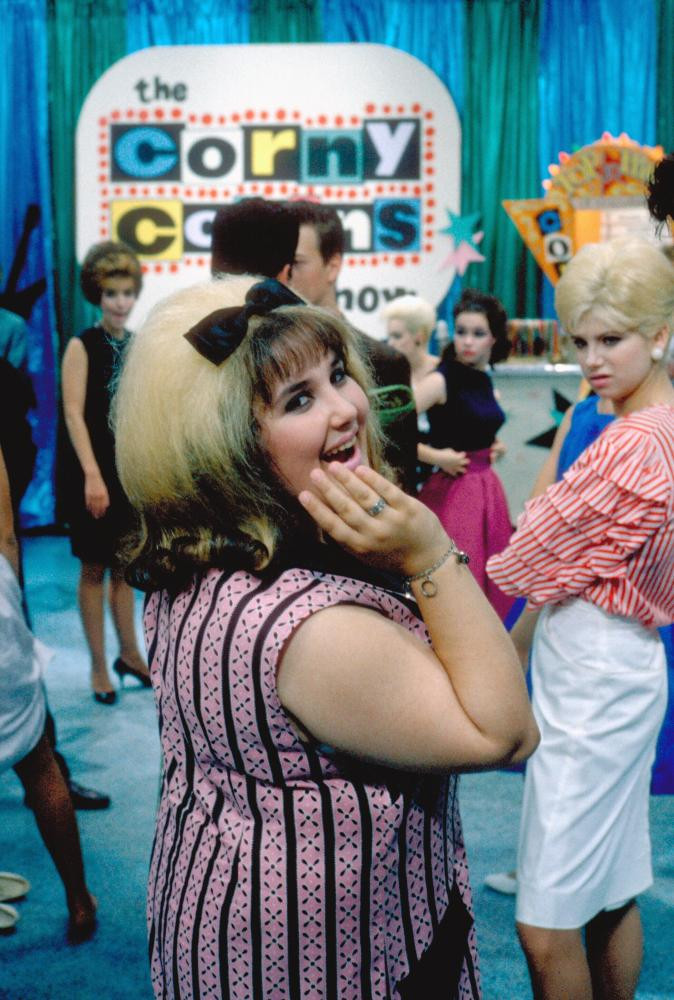John Waters’ films often defy easy categorization, yet their vibrant and unconventional characters resonate deeply, fostering a sense of empowerment through their unapologetic eccentricity. Among these, Tracy Turnblad in Hairspray (1988), portrayed by Ricki Lake, stands out as a particularly endearing example. Set in 1960s Baltimore against the backdrop of the Civil Rights Era, Tracy, a working-class, plus-size white teenager, dreams of stardom. Her exceptional dance talent propels her onto The Corny Collins Show, a local American Bandstand-esque program, where she becomes an advocate for the show’s Black dancers seeking desegregation. Hairspray‘s enduring appeal led to a Broadway musical adaptation in 2002 and a subsequent 2007 film remake starring Nikki Blonsky as Tracy and John Travolta taking on the role of Edna Turnblad, originally made famous by Divine. Intrigued by how the portrayal of body image in Hairspray evolved across these iterations, particularly after its elevation to a musical film adaptation, a comparative viewing of the 1988 and 2007 films was undertaken.
 Ricki Lake as Tracy Turnblad in John Waters’ 1988 film Hairspray, embodying youthful exuberance and body positivity.
Ricki Lake as Tracy Turnblad in John Waters’ 1988 film Hairspray, embodying youthful exuberance and body positivity.
Initially, the project seemed almost redundant. Tracy’s body size and unwavering spirit are so integral to the narrative that significant alteration seemed improbable. However, a closer look reveals nuanced shifts in the depictions of both body image and race between the two films. While the core characters and storyline remain largely consistent, the remake, in its pursuit of nuance, arguably loses some of the original’s distinctive spirit, resulting in two narratives that, while complementary, highlight each other’s respective limitations.
Nikki Blonsky portraying Tracy Turnblad in the 2007 Hairspray remake, offering a contemporary take on the iconic character.
Tracy Turnblad, as originally conceived, is a celebrated figure for body positivity in cinema. She refuses to let societal expectations or body shaming deter her from embracing her identity as “big, blonde, and beautiful.” Despite facing cruel remarks about her weight from the privileged Amber von Tussle, Tracy achieves immense popularity and captures the heart of teen idol Link Larkin. This narrative presents an idealized scenario for a plus-size woman in the 1960s. The 2007 remake adopts a more explicit approach to addressing size discrimination. Velma, Amber’s mother, explicitly rejects Tracy from The Corny Collins Show due to her weight, and Tracy misinterprets a comment from Link as critical of her size. However, much of the remake’s focus on body image is channeled through Tracy’s mother, Edna. John Travolta’s Edna is portrayed as deeply self-conscious about her weight, having become housebound for a decade to avoid judgment about her size.
While the remake’s treatment of body image aligns more closely with contemporary realities and fat acceptance discourse – particularly in Edna’s storyline reflecting the idea that life shouldn’t be put on hold for weight loss – the original Hairspray (1988) offers a different kind of power. Narratives depicting the real struggles of body image are valuable, but they don’t need to be the only stories about plus-size individuals. Characters like Ricki Lake’s Tracy, who confidently embrace their bodies without angst, can be equally impactful. During her audition, the original Tracy portrays her size as an advantage, suggesting she’s relatable to viewers who are “pleasantly plump or chunky.” Similarly, Divine’s Edna confidently assumes the role of Tracy’s agent without hesitation about societal perceptions of a plus-size housewife. The remake only fleetingly touches upon this gleeful subversion of body stereotypes when Edna’s self-acceptance is linked to her appetite in the finale. In contrast to Divine’s Edna, who is unapologetically deviant from beauty norms and drives the plot forward, Travolta’s Edna begins as a stereotypical sad, plus-size figure, requires external validation to embrace herself, and then evolves into a more conventional comedic plus-size stereotype. Given the remake’s extensive focus on Edna’s transformation, the outcome feels somewhat underwhelming compared to the original’s consistent, bold statement.
While Hairspray (1988) is less overtly transgressive than some of Waters’ other works, it retains a subversive edge notably absent in the remake. A prime example is the “Hefty Hideaway” advertisement scene. Mr. Pinky, the owner of a plus-size boutique, hires Tracy as his spokesperson. This scene revels in stereotypes to achieve a subversive effect. Mr. Pinky’s store is filled with pastries, encouraging customers to “Eat up, girls, eat up. Big is beautiful!” His commercial spot features Tracy modeling while indulging in a pink frosted pastry. The remake significantly alters this scene, reflecting a more cautious approach to body image. The ad spot is removed. In the remake’s Hefty Hideaway scene, Mr. Pinky offers Tracy donuts, but she politely declines, showcasing her as a “good fatty” with self-control. The original’s undercurrent of playful lasciviousness is redirected into Mr. Pinky’s fascination with guessing Edna’s bra size, and his delight upon learning she wears a larger cup size than he anticipated. The remake, seemingly aiming for a more respectable portrayal of body image, inadvertently reinforces a regressive trope: plus-size women’s desirability being reduced to larger breasts.
Although Tracy is white, the narrative of Hairspray is significantly driven by racial dynamics. The central conflict revolves around the fight to desegregate The Corny Collins Show, which features an all-white cast except for “Negro Day,” hosted monthly by Motormouth Maybelle. By centering the story on Tracy’s perspective as an ally to her Black friends, Hairspray (1988) inevitably leans into the problematic “white savior” narrative, which diminishes the impact of its critique of racism. The remake attempts to address this by amplifying the experiences of the Black characters, but without the original’s rebellious energy, these moments lack impact and fail to counterbalance the white savior trope.
The remake further attempts to draw parallels between the struggles of plus-size individuals and Black people. Tracy’s solidarity with Maybelle, Seaweed, and Little Inez is rooted in her feeling of being “different” and underrepresented on television. While the idea of personal struggles fostering empathy is important, the remake extends this comparison into less effective territory. A scene where Edna is initially hesitant about Tracy visiting Maybelle’s record store, but is swayed by a spread of stereotypical soul food during “Big, Blonde and Beautiful,” awkwardly conflates stereotypes about both groups.
Similar to its treatment of body image, the remake sanitizes the original’s portrayal of race. Hairspray (1988) aims to align audience empathy with the Black characters and against racist white adults. Its satirical depiction of racist attitudes is unflinching. Velma and Amber attempt to discredit Tracy by falsely labeling her “mulatto.” Mrs. Pingleton’s fear when walking through a Black neighborhood is underscored by tribal drumming, highlighting her bigotry. These moments are removed or softened in the remake. While the antagonists remain unlikeable, removing the original’s tasteless and ridiculous edge diminishes the ugliness of their racism. Depictions of racism also become less nuanced. The remake includes a scene addressing cultural appropriation, where Velma is angered by the Dynamites performing a song on the white episode that originated on “Negro Day.” This is a more direct, but less impactful, illustration than the original’s subtle satire, exemplified by Link’s cringeworthy line: “our souls are black, though our skin is white.” The remake’s attempt to depict racism realistically while remaining family-friendly leads to glossing over harsher realities, such as police brutality. When Tracy seeks refuge at Maybelle’s house while evading the police, the potential danger to Maybelle and her family is ignored, emphasizing Tracy’s allyship over realistic consequences.
Perhaps the most telling contrast between the two films lies in their portrayal of marginalized groups asserting political power. Protests in Hairspray (1988) are spontaneous, energetic, and disruptive, initially focused on integrating The Corny Collins Show and later shifting to freeing Tracy from reform school. The remake depicts Tracy joining a solemn candlelight march with the Black community as Maybelle sings “I Know Where I’ve Been.” The focus remains on integration, which lessens the white savior narrative, but also sacrifices the vibrant energy that permeates other scenes. This shift to a somber tone for political protest feels forced, suggesting a sense of obligatory liberalism that frames protest as historically confined and devoid of contemporary relevance. A more spirited protest scene would have better suited the teenage dancers’ fight for rock ‘n’ roll inclusivity and would have been more engaging for audiences.
The climax of the 2007 Hairspray offers a moment that somewhat bridges the spirit of the original with the remake’s sensibility. Inez disrupts the Miss Hairspray pageant, outperforming Amber and Tracy in dance votes. By defying arbitrary rules imposed by white authority, Inez expresses herself and achieves her dream of dancing on The Corny Collins Show. Her victory becomes a collective triumph for her marginalized community, elevating the happy ending beyond individual achievement to broader progressive change. However, if the remake aimed to seriously address civil rights, a more radical step would have been to shift the protagonist away from the white savior narrative and center Inez’s story. Tracy Turnblad remains a powerful figure of body positivity, particularly in John Waters’ original Hairspray (1988), but a story truly about racism requires a different protagonist and perspective.

